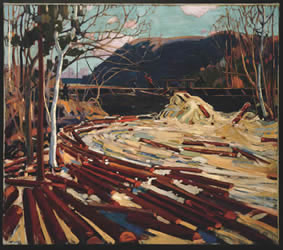H. Mortimer-Lamb
"Studio Talk", International Studio, Sept. 1919
MONTREAL. – The loss to Canadian Art by the tragic death of Tom Thomson in the summer of 1917 cannot be too profoundly regretted. During his brief but brilliant career as a landscape-painter he produced hundreds of sketches and many finished pictures of extraordinary individuality, charm, and power, but remarkable chiefly in that they express a typically Canadian spirit, in a degree never before so concentrated and consistently maintained.
The son of an agriculturist, his youth was spent on a farm in Central Ontario, but at a comparatively early age he left home and went West, where he followed various occupations. During his wanderings he learnt the craft of design and drawing for lithography and engraving, and returning to Toronto obtained employment with a firm of engravers there. Among Thomson’s fellow-draughtsmen and designers at that time were several talented young men with strong artistic leanings. The group included J.E.H. MacDonald, Arthur Lismer, Fred H. Varley, Frank Johnston, and Frank Carmichael, all of whom are now painters of standing. Holidays were spent together by most of the group in sketching from Nature, and they spread these bright periods of the week over the duller working days by free and enthusiastic criticism and discussion of their outdoor efforts.
In the summer of 1912 Thomson made his first sketching trip to the Ontario hinterland which he came to love so well, and whose grim beauty he has since interpreted so inimitably. Thereafter he forsook the workshop in the city except for a brief space each winter when he laboured as a draughtsman that he might earn enough to provide for his frugal necessities to carry him through those glorious nine or ten months when he realized to the full the joy of existence. The sketches he made during those next two or three years are curiously interesting in view of the subsequent remarkable rapid development of his powers of expression. There is little about them to indicate that latent genius which presently was to blaze forth with a suddenness suggestive almost of spontaneous generation. * * *
Thomson had reached the age of thirty-seven before he began definitely to paint in oil. He died when he was forty-two and it was only during the three last years of his life that he was able to give adequate expression to his undoubted genius. Of some of the pictures painted during this period it may be said that they not only represent a high-water mark of landscape-painting in Canada, but would compel homage in any company anywhere. *

In the ordinary sense he received no art training; but no conventional training in the schools could have stood him in such good stead as the preparation circumstances afforded him. During his apprenticeship as a “commercial artist” or designer he was required constantly to solve problems of pattern, proportion, line, colour, effective massing; in draughtsmanship he excelled, and his lettering was a delight to behold. With this equipment he went to Nature and communed with her in all her moods. He was the most constant of lovers, and with increasing intimacy came profound knowledge. No trapper, or fisherman, or backwoodsman of the North Country excelled him in the lore of natural phenomena. And withal was added vision and comprehension and imagination of which only the artist is capable. But still an incentive was needed to spur him to higher creative effort. This came in 1914 through the painter A.Y. Jackson, to whose inspiring influence Thomson owed much, as do also those other members of the little select group of Toronto painters who are devoting themselves to the endeavour of a more typical rendering of Canadian landscape. * * *
Jackson spent the summer of 1913 painting among the Islands of the Georgian Bay. His sketches, upon being exhibited in Toronto, aroused intense interest in the artists to whom I have alluded, and he was at once invited to join the group, of which he really became a leading influence. "There was," he writes. "no attempt or intention to found a school or secede from the art bodies... There was, moreover, nothing revolutionary about our ideas. We felt that there was a rich field for landscape motives in the North Country if we frankly abandoned any attempt after literal painting, and treating our subjects with the freedom of the decorative designer, just as the Swedes had done living in a land with a topography and climate very similar to our own... We tried to emphasize colour, line, and pattern even if need be at the sacrifice of atmospheric qualities. It seemed the only way to make a right use of the wealth of motives the country offered."
During that winter Jackson and Thomson met, and a bond of sympathy was established between them immediately. They agreed to occupy a studio in common, and later in the summer of 1914 worked together in Algonquin Park. This association was to Thomson incalculably helpful. From Jackson he undoubtedly learnt a broader technical dexterity in painting in oil. He acquired this with astonishing ease and became almost immediately his master’s equal.
[…]
The majority of Thomson's important pictures that so far have been disposed of, have, most happily, been acquired for the national collection at Ottawa, thanks to the foresight and discernment of the Commissioners. The largest private collection is that owned by Dr. James MacCallum, of the University of Toronto, between whom and the artist there existed a warm and intimate friendship.

